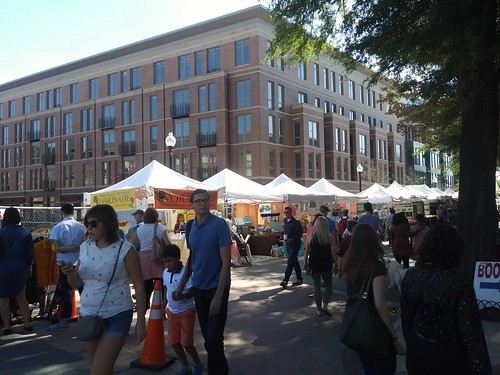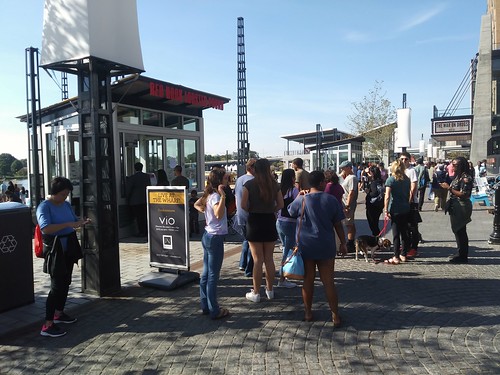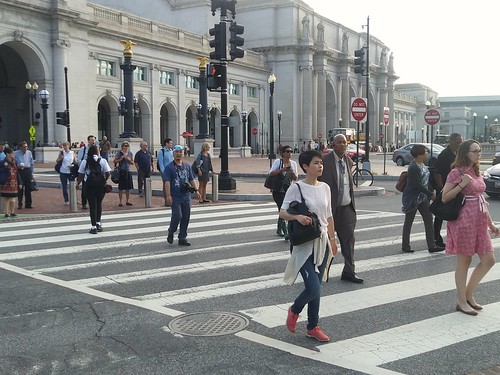Starbucks as an indicator: Anacostia edition
Yesterday's Washington Post has an article, "Starbucks opens its first standalone store in Anacostia," where people in the Anacostia neighborhood "east of the river" lament the entry of Starbucks as the harbinger of "gentrification."
It's true, it is.
But Starbucks doesn't lead change, it follows it ("Not understanding how retail chains make property decisions," 2015), even if in this case the company chose this location as part of an initiative to open stores in otherwise economically lagging and underserved areas ("Starbucks Says Its New Stores in Low-Income Areas Are Profitable," Bloomberg).
But what this means is that the process of reproduction of space ("Sociology of Space: A Use-Centered View," City & Community, 1:4, 2002) in close-in neighborhoods "east of the river" that had typically been home to low income demographics is now evident despite continuing problems of public safety and lack of amenities.
In a piece I wrote in 2011, "Revitalization in stages: Anacostia," I made the point that successful revitalization requires the achievement of a critical mass of people committed to change, so that improvement can take on a momentum of its own.
The challenge in revitalization is how to move communities forward when the population is predominately low income. By definition, in a market economy, you need money to be able to participate, and the more money you have, the better your position.
In an economy that has shifted from cities to suburbs, to services (see the book When Work Disappears by William Junius Wilson), and to knowledge-intensive professions, there are few opportunities for high wage income jobs on the part of the less educated ("Why Young, Black Men Can't Work," Colorlines) which is accentuated by racism.
Cities need to do more to create more focused opportunities for job development through training programs and the creation of social enterprises and supportive work environments (see "One potential solution to finding work for homeless adults," 2017 and "a working document I wrote in 2005 proposing a community development initiative in DC's Ivy City neighborhood").
One example is how DC Water is supporting the development of "green jobs"--construction jobs involving street, landscape, and water infrastructure ("DC Water and District officials kick off green projects to improve the health of Rock Creek and the Potomac River," DC Water press release). From the release:
“Over the past year, we joined the Water Environment Federation and several partners to develop a nationwide certification program to train workers in installation and maintenance of green infrastructure. Today we realize the promise of a greener city with good, professional green jobs for people who need them,” said DC Water CEO and General Manager George S. Hawkins. ...Construction jobs are not low skilled, but they don't necessarily involve school-based learning after a certain point.
Several graduates of the course are employed by Anchor Construction, the contractor building these green infrastructure projects. The hiring process is part of DC Water Works, a larger program aimed at identifying and developing qualified talent for in-demand jobs and to support community-based job creation in the District.
But for a variety of reasons, DC's black population over time has lost access to these types of jobs ("The Crane Drain: These days, office buildings and condos sprout faster than grass. So why isn't there more work for black hard hats?," Washington City Paper, 2002).
As someone who has lived in the city now for 30 years, starting back when what DC is today was completely unimaginable, there is no question that the influx of population has had many salutary effects--safer communities, more amenities--and some negative, hyper escalation of housing prices, displacement of those of lesser means.

New building on the old Hine Junior High School site between C, 7th and 8th Streets, and Pennsylvania Avenue SE, and Sunday Flea Market. The building includes a Trader Joe's (which seems particularly small to me.)
But the challenge of how to ensure that more people participate in significant ways within the local economy remains.
Labels: building a local economy, commercial district revitalization, demographics, neighborhood revitalization, workforce development





2 Comments:
Yeah I agree Starbucks is a lagging indicator. But short of your Marshall Plan to address systemic poverty what do you suggest?
That's the toughest question there it. It's the crux. I think the thing is to reformulate how we use public work and public works, to be structured settings for integrating people back into the workforce.
But I think people need to accept that the best paying work is knowledge based.
The other strategy is to increase wages for jobs, like what started in Seattle. But at a certain point, businesses make only so much money and changing the wage structure significantly makes them uneconomic.
E.g., DCFPI used the new Wharf development as an example of DC putting lots of money in for incentives and infrastructure, and suggests that in return the developer require businesses to pay higher wages, etc., plus ensure more people working on the site are DC residents etc.
I don't know how to feel about that. The fact is we have a bifurcated economy. Certain types of service jobs can only pay so much. And it's not like the businesses, outside of the restaurants, have many employees. E.g., how many people do you need to run a small bookstore or a liquor store?
So getting back to the Marshall Plan, it comes down to investing in civic assets and programs, but also refocusing on building a local economy along the lines of what is recommended in _Community Economic Development Handbook_.
■ developing the community work force;
■ revitalizing the commercial district/industrial base;
■ growing good neighborhood-based jobs; and
■ developing micro-businesses.
=====
I remember you thought well of the point I made in the writings about the Wizards practice facility, in leveraging the food service operation there to support business development.
It turns out the Falcons are doing that with some of the operations in their new stadium. I've been meaning to write about it.
https://www.fastcompany.com/40468583/in-the-new-atlanta-falcons-stadium-one-restaurant-has-a-mission-beyond-food
The Westside Works jobs development initiative mentioned in that article is along the lines of other initiatives I've mentioned in the past like the Evergreen Cooperatives in Cleveland or the Push Buffalo green business operation.
Having working businesses that are also social enterprises in that they train, provide extra supports to workers who need them, capture the "profit" to support these initiatives and maybe to pay more in wages, etc., might be the business side element of the Marshall Plan.
Post a Comment
<< Home